From the Bauhaus Museum Weimar you can see the Buchenwald concentration camp; from the Bauhaus Museum Weimar you can exactly locate the violence and inhumanity of the NSDAP.
However from Bauhaus Weimar and Bauhaus Dessau and Bauhaus Berlin locating the NSDAP is a lot less straightforward; from the Bauhauses seeing the NSDAP is not as simple, the view towards the NSDAP being as it is partially hidden, lightly distorted, unfocussed, by the mists of an unquestioned post-War narrative. And that despite, or perhaps exactly because of, the various and varied links between the Bauhauses and the NSDAP.
With the exhibition programme Bauhaus and National Socialism the Klassik Stiftung Weimar enable a much clearer view on not just the NSDAP from the perspective of the Bauhauses, but also allow for more nuanced reflections on a still astoundingly relevant, if often incompletely discussed, chapter in European (hi)story.......
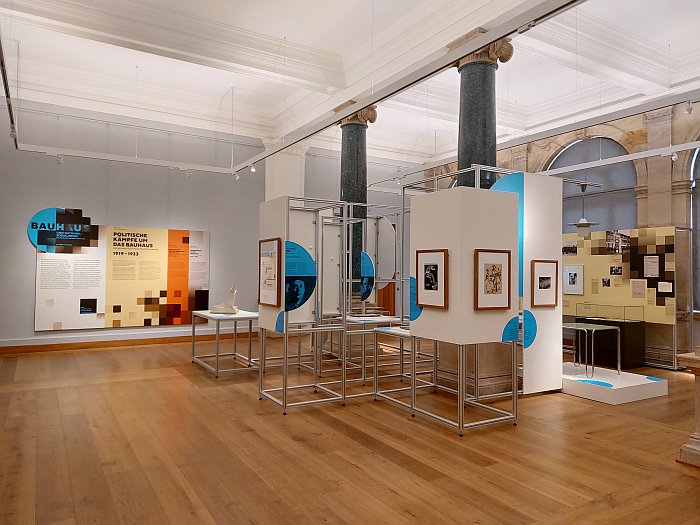
While the fact that Bauhaus Weimar opened its doors in 1919 is popularly known, much less popular attention is paid to what that means: 1919 the year after the end of the 1914-1918 War, that War that ended all Wars, and a defeat in the 1914-1918 War that badly, fundamentally, dented the pride and dignity and self-identity of the German Empire; that German Empire which over the decades had become used to winning wars and defining politics and economics in Europe, had been roundly humiliated. The populace were not amused. A revolution rolled through the land, the Kaiser was informed he'd abdicated and was forced to flee, the Empire was extinguished and in August 1919 a new German Republic was established, in Weimar.
A 1919 of change, instability and a tangibly collective hurt pride that invariably saw a great many yearn for the Germany of the past, that strong, dominant, reliable, winning, Germany. A Germany with a Kaiser. And a Germany symbolised for many, not least by many in Weimar, that new centre of the new German Republic, by the Viergestirn of Weimar Klassik: Goethe, Schiller, Herder, Wieland.
And in the midst of this longing for the revival of the strength and superiority of Weimar Klassik, for the invincible Germany of yore, Weimar in 1919 found itself not only the centre of the new Republic but, and as discussed in detail in context of Mathilde von Freytag-Loringhoven. Painter, Author, Animal Psychologist and Bauhaus Critic at the Stadtmuseum Weimar, found itself home to a multitude of international avant-garde ragamuffins. An international multitude whose new school had seen the much revered, certainly in context of Weimar Klassik, Großherzoglich-Sächsische Kunstschule merge with the Kunstgewerbeschule thus further denying memories of Weimar past; an international multitude who were international i.e. not only German; an international multitude whose understandings of an emancipated egalitarian society had but little in common with the social structures and orders of yore. A multitude of international avant-garde ragamuffins desirous to replace and reset all that embodied and defined by Weimar Klassik.
Weimar Modern as a direct and open challenge to the Weimar Klassik that would restore the nation's pride and return its full power.
Looking back you can see just how obvious the problems in Weimar in 1919 were. Even, if as noted in context of the Radio smow Bauhaus playlist, the music of Johann Sebastian Bach was very much admired on both sides of the divide, was, as Martha Ganter opines a "connecting element of a collective cultural identity"1; music as something that binds, music as a unifying bond. If Bach didn't prove to be the strongest of bonds. And problems that became magnified in context of the economic crises of the early-1920s; that period when things got even worse than they unquestionably already were.
But not as bad as they were going to get.
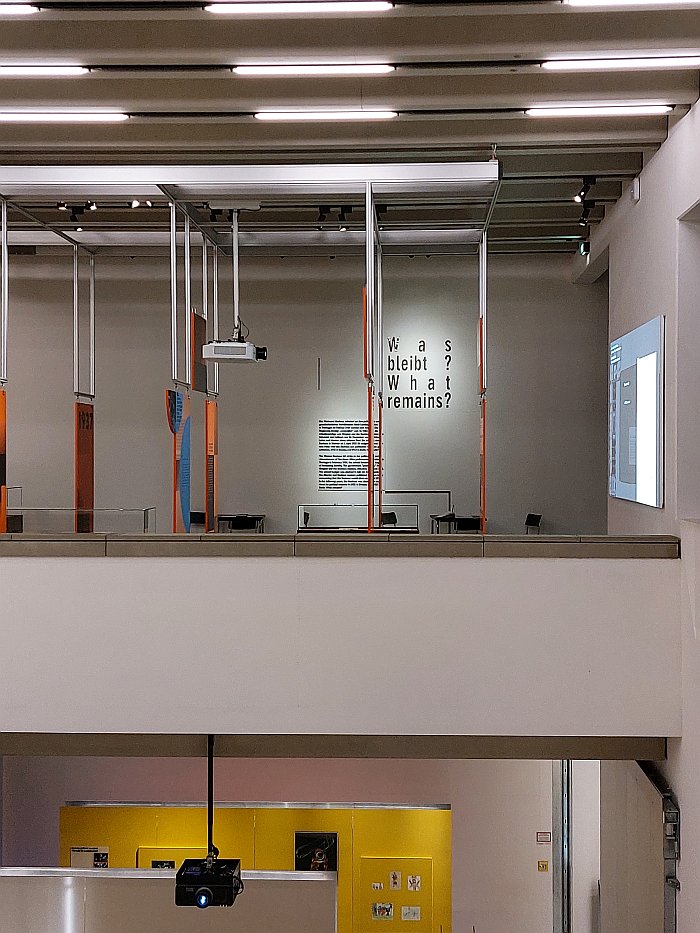
A hurt national pride, for all a hurt national pride associated with an economic crisis, and a longing for a still tangible past threatened by the new, threatened by things that didn't exist before and by people born in countries other than your own, that was, and will always be until human society matures, a happy hunting ground for populists of all political hues; a hunting ground the NSDAP, as discussed in context of Design of the Third Reich at Design Museum Den Bosch, ‘s-Hertogenbosch, knew best to manoeuvre in the 1920s and 30s. Manoeuvers that included both invoking the glory of the theoretical, romanticised, idealised, Germany many sought a return to, and of dealing with those problematic international avant-garde ragamuffins who were seeking to take Germany in an alternative direction: when the NSDAP took control, or at least had the decisive power over, the regional government in Thüringen, Bauhaus Weimar's funding was stopped; Bauhaus moved to Dessau; until the NSDAP gained control in Dessau; Bauhaus Dessau's funding was stopped; Bauhaus moved to Berlin. Where the NSDAP didn't directly close the school, that was a decision taken by, amongst others, Walter Gropius and Ludwig Mies van der Rohe, although they admittedly had but little real choice in the matter. The NSDAP were ultimately responsible for the permanent closure of Bauhaus.
And thus flows the popular narrative of the relationship between the Bauhauses and National Socialism: an international avant-garde with a world view diametrically juxtaposed to that of the NSDAP hounded through the land and ultimately into extinction. A narrative that quickly established itself post 1939-1945 War, not least through the loyal efforts of the Museum of Modern Art, New York, to propagate the Bauhaus narrative Gropius wanted, and also through the efforts of the two Germanys to use the fate of the Bauhauses to distance themselves from the NSDAP. And from one another. And all ably aided and abetted by the incomplete, rarely undertaken, serious academic research on the subject. Whereby, yes, most of the key documents were in the depths of a DDR that, certainly initially, had huge problems in working out how to deal with the Bauhaus legacy it had inherited, problems which didn't increase their interest in aiding access to the documentation.
Yet, and as with near everything in life, it wasn't and isn't that black and white.
A fact Bauhaus and National Socialism elucidates and discusses in the course of three exhibitions: The Bauhaus as a Site of Political Contest, 1919-1933 in the Museum Neues Weimar, Removed – Confiscated – Assimilated, 1930/1937 in the Bauhaus Museum and Living in the Dictatorship, 1933-1945 in the Schiller-Museum.
A triumvirate of exhibitions there is no predefined route though, you can choose your own path, whereby the one described below is perhaps the most meaningful.......
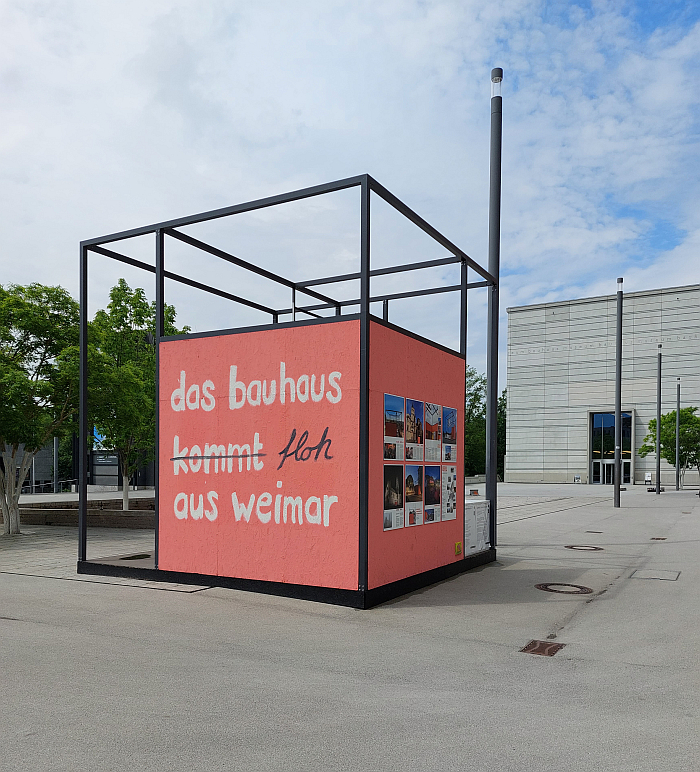
The best place to start viewing Bauhaus and National Socialism is, without question, The Bauhaus as a Site of Political Contest, 1919-1933 in the Neues Museum Weimar, a presentation which takes you on a brief tour through the (hi)stories of not only the three Bauhauses, their times and contexts, but which also, and pleasingly so, stays in Weimar and Dessau after Bauhaus left to explore what became of not only the buildings but also the legacies after the institution had moved on. That thing that Bauhaus biographies rarely if ever do but which as The Bauhaus as a Site of Political Contest, 1919-1933 elegantly demonstrates is as interesting and informative in context of the development of creative education and German politics and society in the 1920s and 30s as exploring the buildings while Bauhaus called them home.
Thus The Bauhaus as a Site of Political Contest remains in a post-Bauhaus Weimar alongside, by now, ex-Bauhäusler such as, for example, Wilhelm Wagenfeld, Erich Dieckmann or Otto Lindig who continued to teach and advocate aspects of Bauhaus Weimar at the new Bauhochschule Weimar; or did so until 1930 when Paul Schultze-Naumburg was appointed director and, essentially, placed the institution at the behest of NSDAP. A Paul Schultze-Naumburg whose 1928 book Kunst und Rasse, Art and Race, a work presented in the Museum Neues Weimar, not only underscores his own political persuasions but also the near universal role questions of race played in the NSDAP's toxic world view, everything was race, everything was a clear racial hierarchy, even creativity. A point the triumvirate of exhibitions regularly returns to and thereby reinforces. And forces you to dwell on, in context of then and now. And a 1930s that also saw the NSDAP remove, destroy, many works by Bauhäusler in Weimar, including, for example, Oskar Schlemmer's murals in the former Bauhaus school building; Gropius's Denkmal für die Märzgefallenen, Monument to the March Dead, an expressionist memorial for those who had defended the fledgling Republic in the face of the March 1920 coup attempt; or Gropius's plaque commemorating the signing of the Weimar Constitution in August 1919, a plaque which stands in The Bauhaus as a Site of Political Contest where for all it looks thoroughly unremarkable today, the reduction and clarity of the text was still a relatively novel approach then. And the parliamentary democracy inherent in the constitution not the sort of thing the NSDAP were in any sense favourably inclined to.
And The Bauhaus as a Site of Political Contest also remains in a post-Bauhaus Dessau in which the NSDAP had not only promised to close Bauhaus should they win the regional elections in 1931, but also to demolish Gropius's school building. Such were actual campaign issues in Sachsen-Anhalt in 1931. They won the election, closed Bauhaus, but didn't demolish the building, not because they thought it would be more fun to let the DDR struggle with the legacy and the question of what to do with it, and ultimately allow it to fall into disrepair, but for the much more prosaic reason that they needed the space it offered. Not least for educational institutes: in the 1930s Gropius's building providing a home for institutions as varied as the Gauamtswalterschule, a school for local government functionaries, and the Landesfrauenarbeiterschule, a school for female arts and crafts if one that rather than developing the "neue Zunft der Handwerker" 'new guild of artisans' Gropius had demanded in the 1919 Bauhaus Manifesto tended to reinforce not only traditional gender stereotypes but the NSDAP's employing of the romanticised folkloric myths of Land and Volk, something wonderfully illustrated through a late 1930s embroidery by Else Dix depicting German females in traditional regional dress, invariably invented traditional dress that one notes remain deeply entrenched, and popularly unquestioned, today. While the inclusion of females from, for example, Siebenbürgen, Sudetenland and Lithuania helps underscore the NSDAP's understanding of 'Germany' in the late 1930s.
A tour through the (hi)stories and political contexts of the three Bauhauses and their buildings populated by a mix of archive documents, photos and sketches, including for example, an appallingly openly anti-Semitic cartoon that takes great delight in Bauhaus's departure from Dessau; or a photo of a group of Bauhäusler lounging around outside Bauhaus Berlin in which the mix of wooden stools and the sheet steel Rowac Schemel beautifully highlights not only the changes of the period in which Bauhaus was active, and actively contributed to, but the fact that the new rarely eliminates the old rather joins it; or the 1932 Illustrieter Beobachter article Bolschewistisches Bauen, Bolshevik Building, which denounces innumerable contemporary architectural projects, including decrying Gropius's Denkmal für die Märzgefallenen as a "Totenschändung", 'a desecration of the dead'. Or the 1931 article Das Bauhaus auf dem Wege zum Faschismus, Bauhaus on the way to fascism, in the Arbeiter-Illustrierte-Zeitung, A-I-Z, a heavily socialist leaning magazine of the period, and an article that on the one hand completely disses the idea that Bauhaus was an institution interested in the working class rather noting that, certainly under Gropius, the workshops in Dessau "created luxury items that are worthless to the proletariat" and on the other tends in its re-telling of the (hi)story of Bauhaus to predict the narrative of the communist Bauhaus closed by the NSDAP that has become so firmly established today. Thus underscoring the complicated political location the Bauhauses occupied in 1920s and 30s Germany, the complexities of the Bauhauses relationships with their contemporaries and their age. And how those complexities influence the contemporary narrative. And thus the need for more objectivity than an A-I-Z could ever achieve.
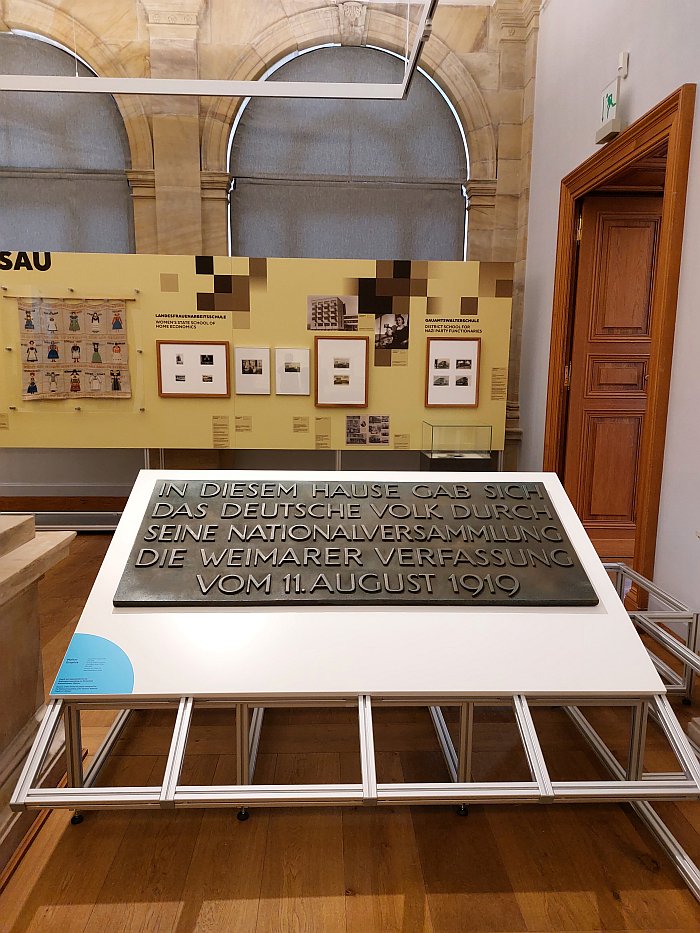
And also populated by works created at the three Bauhauses including, for example, Farkas Molnár's pamphlet for the unveiling of Gropius's Denkmal für die Märzgefallenen, or Gropius's Totenschändung, depending on your perspective; the 1928 collage Es wird marschiert, On the March, by Marianne Brandt and the 1932 collage Schlag gegen das Bauhaus, Attack on the Bauhaus, by Iwao Yamawaki which help elucidate that political comment and observation, and opinion, were very much things at the Bauhauses; an early 1930s lamp by Heinrich Siegfried Bormann for Kandem that is not only a wonderfully expressive playing with the geometric forms that were such a central aspect of much of the Bauhauses, but also a reminder of the Bauhauses varied commercial cooperations, cooperations that as A-I-Z rightly pointed out were only rarely in context of the democratisation through design that is so often (lazily) attributed to the Bauhaus. Much more: they needed the cash. And also, given the context, a nice reminder of the fact that Kandem were one of the leading developers and producers of contemporary lighting technology in the first third of the 20th century and who as such provided the NSDAP with the lights, the cutting edge lighting technology, with which they illuminated so many of their events, not least those mass rallies in Nürnberg that did so much to establish their authority and terror. Or a club chair by Erich Dieckmann, a work created in context of his tenure at the Bauhochschule Weimar, i.e. after Bauhaus Weimar, but which one can effortlessly follow back to Dieckmann's time in the Bauhaus Weimar carpentry workshops and which not only embodies and discusses many of the positions of the period as regards furniture and interiors, but also helps underscore how interesting and informative a designer Dieckmann is and was.
And a tour undertaken in the company of the biographies of the likes of, and amongst others, a Gunta Stölzl, the Werkmeisterin in the weaving workshop, one of the defining protagonists of not just the Bauhaus weaving workshops but the development of weaving in the 1920s and 30s, and who, as one can read in The Bauhaus as a Site of Political Contest, was hounded out of Bauhaus by Bauhäusler, and that not least on account her marriage to the Jewish Bauhäusler Arieh Sharon; Johannes Itten, that central figure in context of the Vorkurs in the early Bauhaus Weimar years, and while it's always unfair to mention that which isn't on show in any exhibition, the blink and you'll miss it reference to Itten and Mazdaznan could, should, must be extended upon, for while not exactly mirroring the NSDAP's positions, indeed the NSDAP outlawed Mazdaznan in 1935, it is a movement based on the simplistic weaving of esoteric concepts and dangerous mergings of (hi)story and folklore and fantasy, and a fascination with racial distinctions, and the origins of human life, that, and as we all know only to well from recent experience, can provide for an accessible bridge to extreme right wing positions, and thus a discussion on Mazdaznan, in our opinion, Bauhaus and National Socialism needed to give more prominence to. For all because its being staged in Weimar where Mazdaznan was prolific, endemic, in Dessau less so. Or Hans Groß, a student at the Großherzoglich-Sächsische Kunstschule Weimar who was one of the earliest Bauhaus Weimar students and who in 1919, and as discussed from Mathilde von Freytag-Loringhoven. Painter, Author, Animal Psychologist and Bauhaus Critic caused the first major internal problem for the young institution when he denounced the lack of a Germanic identity at Bauhaus and the promotion of international perspectives, and thereby exposed that the nationalistic and völkisch positions held by many outwith Bauhaus Weimar also existed within Bauhaus Weimar. A reality that became even clearer when Groß and other students left Bauhaus on account of the, perceived, anti-Germanic stance of the instiution. Hans Groß, perhaps unsurprisingly, went on to have a successful pedagogic career in the NSDAP.
And a Hans Groß one also meets a little further down the road in the Bauhaus Museum.
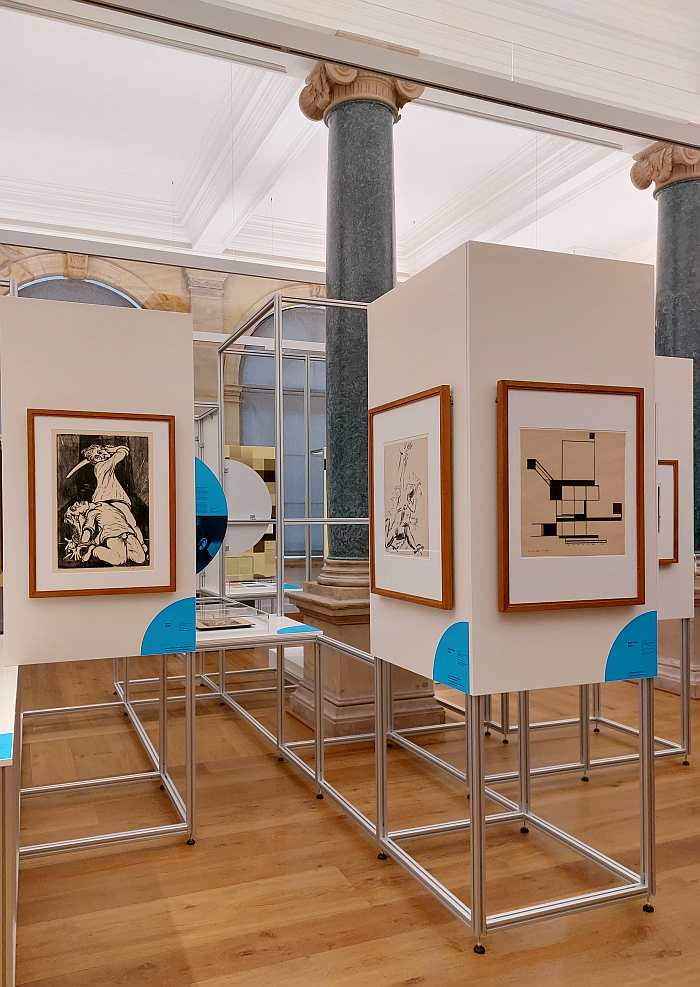
Amongst the more popularly known episodes of the NSDAP dictatorship as it relates to creatives and creativity, alongside book burnings, is the declarations, denunciations, in the 1930s of contemporary, avant-garde, expressionistic, modern, et al artworks as entartete Kunst, degenerate art. An aspect of the NSDAP dictatorship, a 1930s cultural war, approached in Removed – Confiscated – Assimilated, 1930/1937 from a number of perspectives.
Initially from an (hi)storical perspective in context of Weimar and the Weimar Bauhaus, Weimar Bauhäusler, starting with the 1930 purge of the Weimar Museum of contemporary art following the so-called Frick Decree, a proclamation by Thürngen's NSDAP Interior Minister, a decree whose official title "Wider die Negerkultur für deutsches Volkstum", 'Against Negro culture on behalf of the German people' leaves one in no doubt as to the world view from which it was written, and which denounced "foreign racial influences" in Germanic culture, a "decomposition" whose removal was in the "interest of preserving and strengthening the German people"; language of which a Hans Groß would invariably have approved, yet which in the difference to the language of Groß's denunciation, the escalation in tone and rhetoric, neatly illustrates how the dialogue developed in the 1920s. And is also a reminder of how close and relevant the early 1930s are in the early 2020s. Before moving over the confiscation of further contemporary works in 1937, works that NSDAP declared to be "products of the period of decay" i.e. before they took, seized, power, and ending with the presentation in Weimar in 1939 of the touring exhibition Entartete Kunst, an exhibtion that more or less carried the official subtitle "Schreckenskammer der Kunst", 'Artistic Chamber of Horrors", and in which contemporary works were defamed and degraded and mocked. As were the artists who created them.
Having set the (hi)storic academic context Removed – Confiscated – Assimilated moves on to explore the art the NSDAP entartet, with again a particular focus on Weimar Bauhäusler such as, for example, Lyonel Feininger, Hans Haffenrichter, or Johannes Itten whose 1921 architectural study House of the White Man tends to underscore the above opined need for a wider discussion on Mazdaznan at the early Weimar Bauhaus. And by Paul Klee, whose 1922 work Löwen, man beachte sie!, Lions, be on your guard, is the most joyous work we've seen in a long, long time. Yes, your attention will be very much drawn to the works by Lyonel Feininger hanging either side, but Klee's warning of the dangers of lions is inarguably the least expressionistic, least abstract, least Neue Sachlichkeit painting by an active Bauhäusler you will ever see, is one of the most macabre paintings you'll see, one of the most fun paintings you'll ever see, and one of the most direct warnings of impending danger and of the need to pay attention before its too late to respond to that which is already in the process of defeating you, you will ever see. A work that has lost nothing in terms of relevance and contemporaneousness in the intervening 102 years. And also, in many regards, can be considered an early expression of that questioning, that playful subjugation and deconstruction, of the tenets of Modernism that became so prevalent in the 1960s.
And also features an entartet work by the aforementioned Hans Groß, who for all he may have been an early supporter of the NSDAP's völkisch positions, the NSDAP were less keen on his art. Or at least not keen on his 1918 woodcut they denounced as entartet. Not that the entarten and dislike harmed his future career.
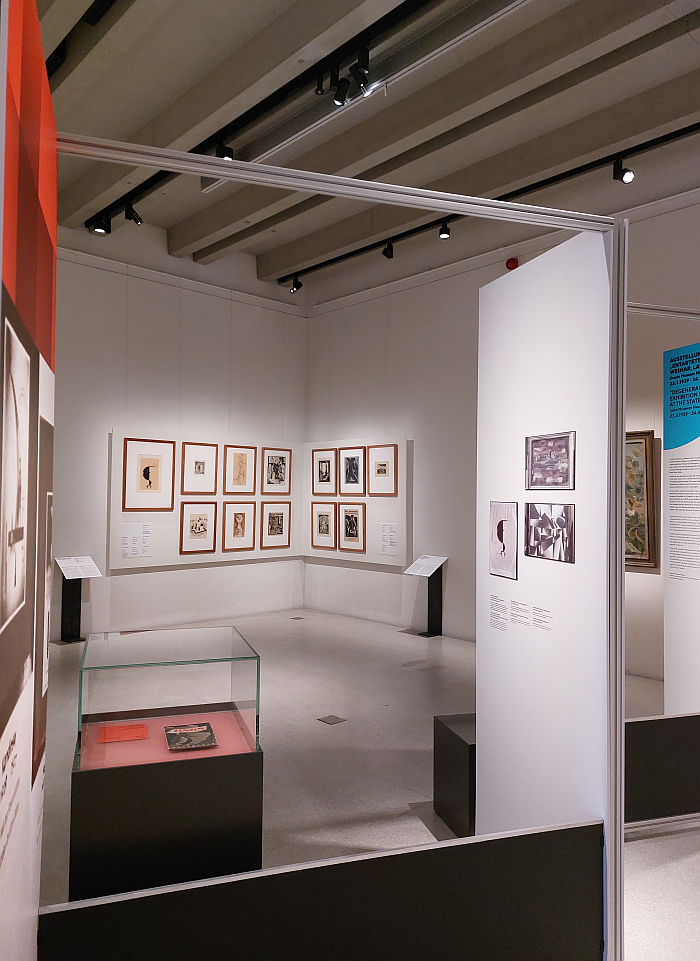
Much more to the NSDAP's liking was that art which was presented in context of the Große Deutsche Kunstaustellung, an annual showcase staged in Munich from 1937 to 1944, an if one so will, counterpoint to the Entartete Kunst exhibition and which can be understood as an attempt by the NSDAP to use, misuse, the museum context by way of promoting an ideological position rather than stimulating a desire to learn and to develop as an individual in a society. A misusing of museums that, again, is a very relevant theme in contemporary Europe. And a Große Deutsche Kunstaustellung discussed in Removed – Confiscated – Assimilated via works such as, for example, Heinrich Basedow's 1936 painting Möwe mit Kutter, a thoroughly fascinating, engaging seagull who appears to have flown in from Surrealism, or from the Metaphysical of a Giorgio de Chirico, to bring news of Neue Sachlickeit, and which may explain why the jury rejected it, despite Basedow being a devoted party member. Or via Wilhelm Imkamp's 1938 portrait of the pianist Elly Ney, a popular musician of the day, not least amongst the NSDAP of whom Ney was also an avid supporter; and a portrait that Hitler, clearly a Ney fan boy, purchased. And a Wilhelm Imkamp who we will meet again shortly.
And also via works by artists who had been entartet but who had now toned down their more abstract and expressionist mannerisms, that Assimilated of the exhibition title, and who were now working in the more realistic contexts the NSDAP approved of. Biographies of assimilation very neatly illustrated by a comparison of Hans Haffenrichter's entartet 1923 sculpture Crouching Woman, a flowing, curving, faceless expressionistic work created at Bauhaus Weimar and his 1935 group of lions, specifically a mother and cub, which stands proxy in Removed – Confiscated – Assimilated for a number of realistic animal sculptures Haffenrichter presented in context of the Große Deutsche Kunstaustellung. And creative assimilation with a murderous totalitarian regime embodied in lions that brings one neatly, and very satisfyingly, back to Paul Klee.
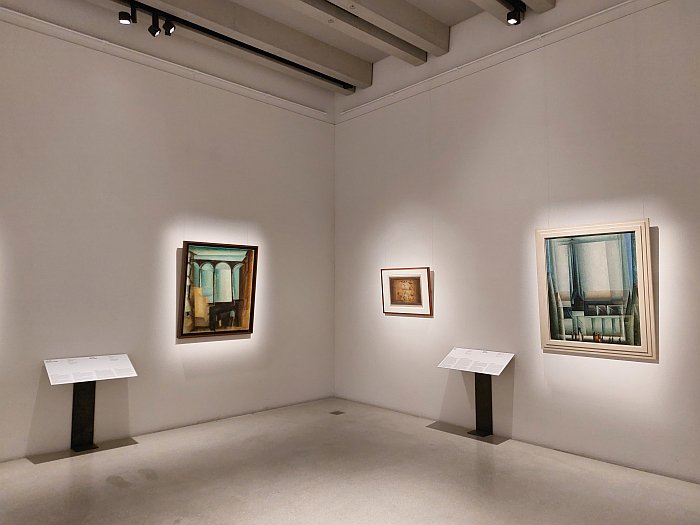
Beyond Removed – Confiscated – Assimilated the Bauhaus Museum Weimar is also hosting the installation Denkmal über Ehrlickeit by Friedrich von Borries, Jens-Uwe Fischer and Frieder Bohaumilitzky, an introduction to Franz Ehrlich, a genuinely fascinating character whose biography includes stations at Bauhaus Dessau, the antifascist resistance, Buchenwald concentration camp as an inmate, Buchenwald concentration camp as an NSDAP employee, VEB Hellerau furniture factory, the Stasi, amongst other apparent incompatibles; however, a genuinely fascinating character who we'll somewhat skip over here, save to recommend von Borries and Fischer's book Gefangen in der Titotalitätsmaschine, a work sadly only in German for it is a work of universal relevance as a nourishing matrix for reflections on individuals in totalitarian systems of all possible hues, that is most relevant today. And may become ever more so in the not to distant future.
And also to note that in using Ehrlich's 602 furniture series for VEB Hellerau as the basis of Denkmal über Ehrlickeit, Monument to Honesty — it's a play on the German Ehrlich/Ehrlichkeit — von Borries, Fischer and Bohaumilitzky aside from an introduction to Ehrlich, for a discussion on Ehrlich as standarisable as his furniture, allow access to reflections on the dangers of design in the hands of politicians and also on the complexities of the DDR's relationships with both Bauhaus and the legacy of NSDAP. Neither of which are as clear cut as one could expect. Or as often presented. And are equally worthy of greater popular discussion than they currently are. As is the former West Germany's relationships with Bauhaus. And, as discussed from PURe Visions. Plastic Furniture Between East and West at the Kunstgewerbemuseum, Dresden, the relationships between the former eastern and western Germanys.
And a Fritz Ehrlich one also meets a little further down the road in the Schiller-Museum.
And indeed meets in front of the Schiller-Museum.
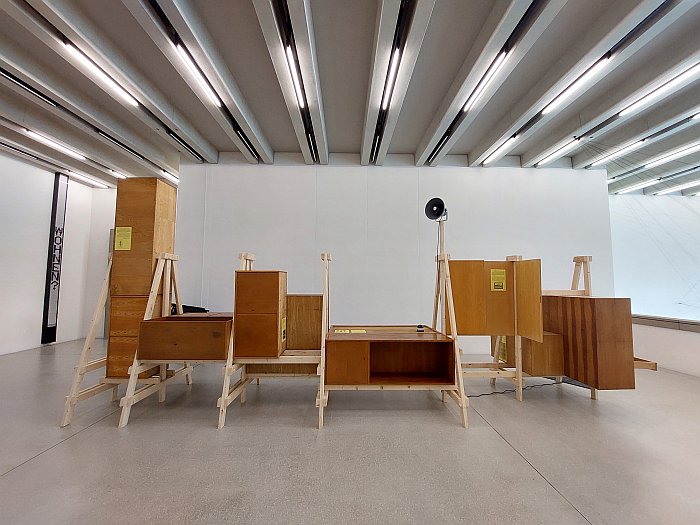
There is an argument to be made, not one we'll necessary make, but an argument to be made nonetheless, that Living in the Dictatorship, 1933-1945 is the central exhibition of Bauhaus and National Socialism, presenting as it does the biographies of a geat many Bauhäusler in context of their careers before, during and after both Bauhaus and the NSDAP.
An essentially thematic presentation that explores the featured biographies in context of creative genres, be that for example, Graphic Design, that so new and dynamic expression of the period, that freeing of visual art from its essentially functionlessness and allowing it to be an active art, and a commercial art, and as represented by, amongst others Herbert Bayer or Irmagard Sörensen-Popitz; Architecture that practice that was meant to be the primary dominion at Bauhaus, the practice all others united under, but never really was, or only very rarely and sporadically was, and as explored in the company of, and amongst other, the three Bauhaus directors Gropius, Meyer and Mies van der Rohe, the first and last of whom undertook a variety of NSDAP commissions, and Mies van der Rohe who simply didn't believe architecture was, could possibly be, political. Or in the company of Fritz Ertl, one of the architects of Auschwitz, one of those responsible for the architectural plans which, as noted from Design of the Third Reich, despite the architects being well aware of they were designing, contain an emotional disinterest that is as terrifying as it is informative. And also in the company of Ernst Neufert who played an important role in establishing the standardisation in architecture and design of International Modernism in the service of the NSDAP, just one, as noted from Design of the Third Reich, of numerous themes and positions of International Modernism and Functionalism the NSDAP happily employed when they felt it was to their advantage, while also denouncing such and advancing a more traditional agenda. A subject we'll come back to in a couple of minutes.
Or the chapter Free Positions? which explores the degree to which artistic license was possible under the dictatorship of the NSDAP, a chapter in the company of works such as a 1939 winter landscape by Marianne Brandt, a creative, who, and lest we forget, which we all often do, initially trained as a painter at the Großherzoglich-Sächsische Kunstschule, Weimar, before moving to, and painting in, Norway and returning to Weimar in 1923 and joining Bauhaus; a 1939 landscape from a period in which, as Elizabeth Otto describes Brandt lived, on account of family commitments, essentially isolated in Chemnitz, and a work which, for Otto, contains "a strong sense of design and rhythm, as if elements of a Bauhaus colour or form exercise were hidden within it".2 Which may or may not be looking a little too hard; but it does have a very clear, communicative structure that is more informed by reality than expressive of that reality. And is without question reflective of the melancholy of a citizen of the world isolated in Chemnitz. If a melancholy that hasn't, yet, given up hope. That was the DDR's job.
A hope that the Greek Moon Goddess Selene appears to have already lost in Gerhard Marcks' 1935 sculpture of her, a work that, as one learns, while not entartet, Marcks was banned from exhibiting. A fate that unquestionably would have befallen Marcks' Hitler bust had it not been cast in 1949; a bust that far from presenting the heroic, invincible Hitler that one is used to depicts a curiously tired, ageing, listless man. Which, no, isn't necessarily a commentary on Marcks' attitude towards the NSDAP. And a bust that stands in the chapter Propaganda diametrically juxtaposed to the majority of the works, works that are very much on message, including the aforementioned Wilhelm Imkamp's 1949 portarit of a member of the German Navy, a blonde haired, blue eyed, rugged sailor below whose tunic you know is the rippling, ripped, body of a Roman warrior. A graphic illustration of NSDAP propaganda porn. And a propaganda chapter that also features photos of the German Army in France by Karl Schwoon; a Karl Schwoon who, as discussed from Between Utopia and Adaptation. The Bauhaus in Oldenburg at the Landesmuseum für Kunst und Kulturgeschichte, Oldenburg, served as a military photographer/photo-journalist on both the eastern and western fronts, roles that, essentially, didn't exist in the 1914-1918 War and thus a reminder how developing technology influences and informs the nefarious art of the propagandist, see also the NSDAP's expert use of radio. And see also contemporary Social Media. And coming A.I. Propaganda upgrading and updating being as dangerous for society as artillery upgrading and updating.
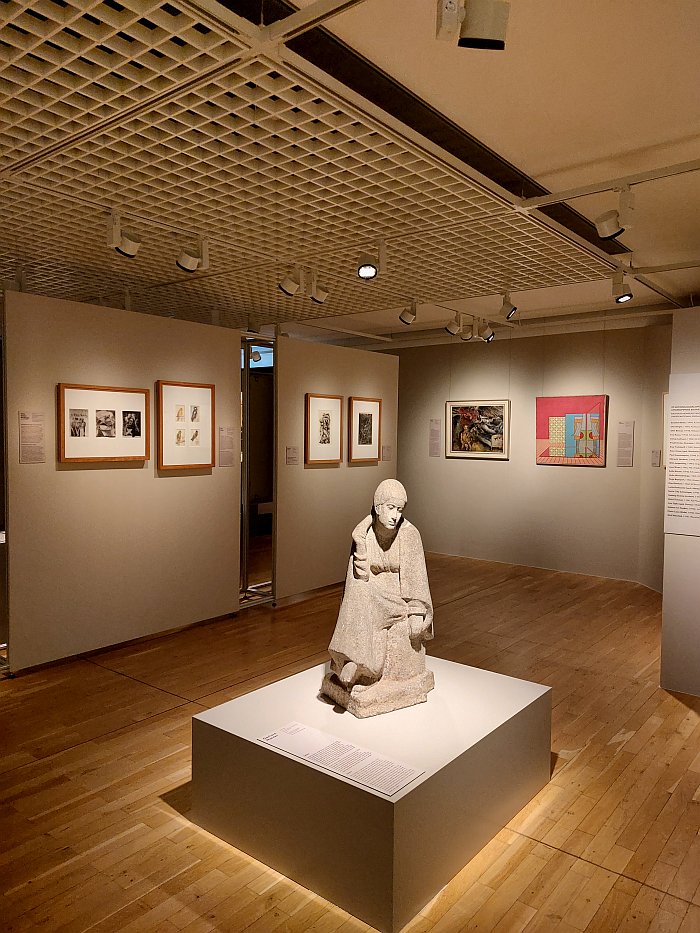
A thematic presentation where we, perhaps not exactly unsurprisingly, spent most of our time within the furniture chapter. A presentation which aside from offering insights into the oeuvres of, for example, the aforementioned Erich Dieckmann or Franz Ehrlich, the later being represented on the one hand by the typography of the 'Jedem das Seine' that adorns the entrance gate to the Buchenwald concentration camp, a copy of which stands in front of the Schiller-Museum, and lettering whose reduction and curvature are often read as resistance by Ehrlich to the NSDAP, a theory Friedrich von Borries and Jens-Uwe Fischer convincingly dispel.3 And on the other hand is represented by a number of architectural and furniture designs from his varied and complex time in and at Buchenwald including a (pseudo)neo-Germanic bench he designed for the SS Falconry at Buchenwald, no honest it was a thing, and which was built by inmates; a work which, as with the 1930s Landhausstil chair seen in context of Design of the Third Reich, poses that question if one can like works with such abominable biographies? We hope so, because we do. As a physical object, not as a concept.
In addition the furniture chapter presents, and as one of very, very few works and creatives on show not directly associated with the Bauhauses, and thus an object whose presence is initially very confusing, a Thonet KS 46 by, strongly attributed to, Anton Lorenz, a steel tube cantilever chair that we first became acquainted with in a photo on show at Power Space Violence. Planning and Building under National Socialism at the Akademie der Künste, Berlin, and met for the first time in person in Weimar. A Thonet KS 46 steel tube cantilever chair of which an example, not the one on show in Weimar, but a Thonet KS 46, was part of the furnishing at Berchtesgaden, Hitler's famed and fabled mountain retreat. A fact confirmed by numerous photos on show in Living in the Dictatorship including those from a, one must say these days, Hitler Home Story published in 1935 in the French magazine VU. "A Berchtesgaden où le Chancelier se repose... et décide", "In Berchtesgaden where the Chancellor rests... and decides", being the utterly chilling subtitle, becoming more so when they speak of the "les graves décisions" made at Berchtesgaden by Hitler and his closest advisors. And an uncritical text in a period crying out for a critical debate that reminds, as wonderfully illustrated in Design of the Third Reich, just how carefully and strategically the personality cult around Hitler was developed and maintained. And which very much focusses attention on contemporary political debates and personality cults around politicians. ¿Have we honestly learned nothing? ¿Why not?
A Thonet KS 46 steel tube cantilever chair which as with Ernst Neufert's above noted standardisation, or as discussed from Power Space Violence. Planning and Building under National Socialism, the basing of the urban plan for Stadt des KdF-Wagens a.k.a. Wolfsburg on the from Le Corbusier initiated Charter of Athens, or as discussed from Design of the Third Reich the use of a rational reduction and repeating typographies by the NSDAP's, for want of a better phrase, workplace design organisation Schönheit der Arbeit for a wide variety of objects of daily use, or the use, as can be seen in a photo on show in Living in the Dictatorship, of four Marcel Breuer B 32 steel tube cantilevers for Thonet as seats for visitors in the 1935 exhibition Wunder des Lebens in Berlin, that clearly doesn't fit in with the accepted narrative of the NSDAP rejecting Modernist positions and all trappings of Modernist society, of the NSDAP as sworn opponents of Modernism, Functionalism, et al, defenders of a ancient Germanic identity and culture: things weren't that clear cut, and understanding that, understanding how the NSDAP picked and chose their way through design and architecture by way of aiding and abetting their poisonous propaganda and the realisation of their abhorrent objectives, how they actively used, misused, abused and misappropriated architecture and design for their barbaric ends, is important in not only understanding the NSDAP, nor only in understanding the development of architecture and design in a period when most don't focus on the architecture and design, but also, arguably primarily, in context of better understanding the links between architecture and design and society, between architecture and design and the development of human societies, immaterial society as much as the material manifestations of that society.
Thus for all the Thonet KS 46 has nothing to do with Bauhaus it's inclusion is very relevant and welcome because of the insights it allows and the manner in which it forces you to question everything you assumed you knew about the relationships between International Modernism and the NSDAP, between the Bauhauses and National Socialism, as does a Hans Groß, or the hounding of Gunta Stölzl, or Mazdaznan, or many other examples to be found in the three exhibitions; helps underscore that while, as noted above, political comment and observation, and opinion, were very much things at the Bauhauses, it wasn't only from the extreme left wing perspective the popular narrative tells us it was, wasn't only critical of the NSDAP, which it also was, as can be seen and studied in the course of Bauhaus and National Socialism, but was also from the extreme right wing perspective. As was the political discourse in the German society of the 1920s and 30s. The parallels shouldn't surprise anyone, no-one should be surprised that the Bauhauses were mirrors of German, European, society in the 1920s and 30s. But for decades it wasn't considered polite or appropriate or helpful to openly discuss that reality. A point, again, well return to in a couple of minutes.
In addition the KS 46 poses the question if the NSDAP knew that in the early and mid 1930s Thonet was part of a company network owned by the Jewish entrepreneur Leopold Pilzer?
And is also a genuinely fascinating piece if furniture design, a work that one rarely sees, a work with some very nice details, some interesting and informative construction decisions, interesting and informative upholstery decisions, that in certain aspects goes its own way while gaily employing the existing, and one where in a study of the formal elements it becomes even easier to attribute it to Lorenz, you can see the intent, you can see the influences, see the next steps, can hear Lorenz's brain ticking. Thoroughly fascinating. If a work from the Thonet back catalogue unlikely ever to be reissued. Although they should. It's a biography very much in need of reclaiming.
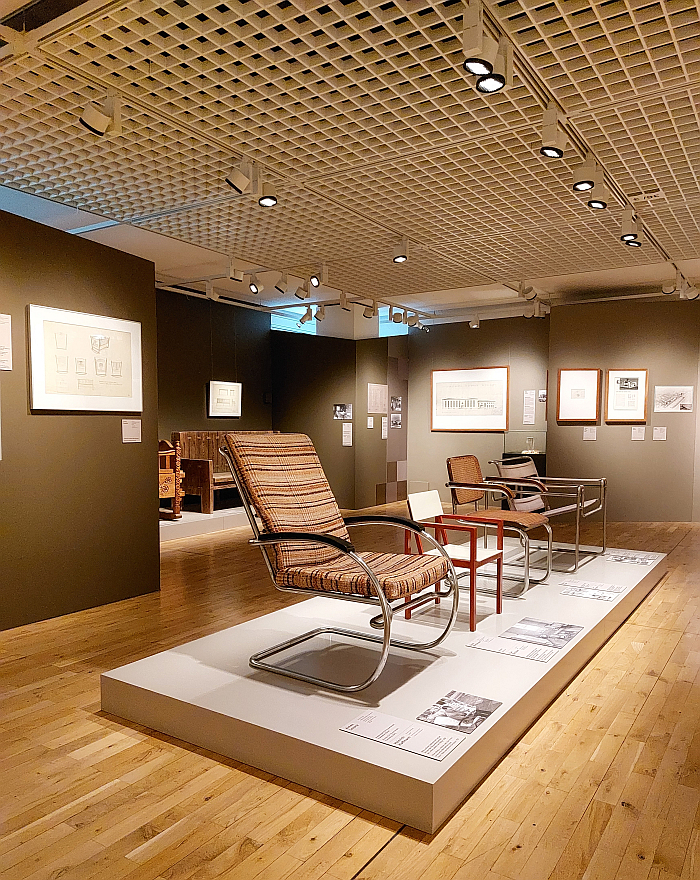
And a thematic presentation that alongside creative genres also explores the featured biographies in context of the Living in the Dictatorship of the exhibition title; explores the featured biographies in context of the paths the myriad featured Bauhäusler took through the 1920s, 30s and 40s, as indeed do, in their own way, Removed – Confiscated – Assimilated, 1930/1937 and The Bauhaus as a Site of Political Contest, 1919-1933; an exploration of Bauhäusler biographies in context of National Socialism, a discussion on the response of individuals to a totalitarian regime that not only runs through Bauhaus and National Socialism but in many regards is at the core of Bauhaus and National Socialism, and whose sharp focussing in Living in the Dictatorship allows for the aforementioned argument to be made that it is the central exhibition of Bauhaus and National Socialism, bringing together as it does a great many threads begun in the Museum Neues Weimar and the Bauhaus Museum and then carrying the newly unified thread forward.
And a discussion on the response of individuals to a totalitarian regime that also allows Bauhaus and the Bauhäusler to be employed as conduits for wider reflections and considerations the hows, whys, wherefores of individual biographies in context of totalitarian regimes.
Reflections and considerations introduced in Living in the Dictatorship through the utter banality of statistics: from the ca 1,250 known Bauhäusler ca. 569, so around half, remained in Germany, 202 left Germany before 1933, 134 leaving after 1933, while the fate of some 363, around a quarter, is still unknown.
Numbers however only rarely explain the full story, are but a digestible summary.
However in the course of Bahuaus and National Socialism's triumvirate of exhibitions one can begin to approach the personal stories the numbers ignore. Can appreciate, for example, that remaining in Germany wasn't always the same as remaining in Germany. There were those who stayed and joined the NSDAP, the curators noting some 188 Bauhäusler signed up, around a third of those who stayed, a fascinating number for all familiar with how contemporary Neonazis use numbers as code, a number that one is unsure if it is high or low; and a number personified by the likes of a Hans Groß, a Karl Schwoon, a Heinrich Basedow or an Erich Dieckmann whose membership of the NSDAP and work with and for the NSDAP organisation Schönheit der Arbeit can, as discussed in context of Chairs: Dieckmann! The Forgotten Bauhäusler Erich Dieckmann at Neuwerk 11, Halle, be seen as, and in many regards was, born of financial need, but wasn't necessarily only of necessity, he was almost certainly open to the politics of the NSDAP. A Dieckmann whose biography reinforces the need to better understand such biographies. And brings us back to that question if one can separate a creative's politics, a creative's character, from their work. For we do very much like a great deal of Erich Diekmann's work. And really don't want him to be a Nazi. But may have to accept he was. And then?
But there's also those who remained and quietly got on with life, those who to varying degrees and for various reasons assimilated, including, for example an Elsa Mögelin who, and as discussed from Else Mögelin. Ich wollte, gegen alle Hindernisse, weben at the Brandenburgisches Landesmuseum für moderne Kunst, Dieselkraftwerk, Cottbus, sought a path of minimum resistance with a tacit assimilation that saw her undertake NSDAP commissions, but only occasionally; or a Marianne Brandt who on account of personal, family, realities found herself isolated, and one assumes not particularly happy, in Chemnitz; or a Margaretha Reichardt who, having almost been expelled from Bauhaus for her role in the above noted hounding of Gunta Stölzl, acquired looms from the Bauhaus weaving workshops following their closure and with which she built, wove, a successful career in Erfurt under first the NSDAP and subsequently the SED.
Or Fritz Ehrlich. Who is a subject in himself.
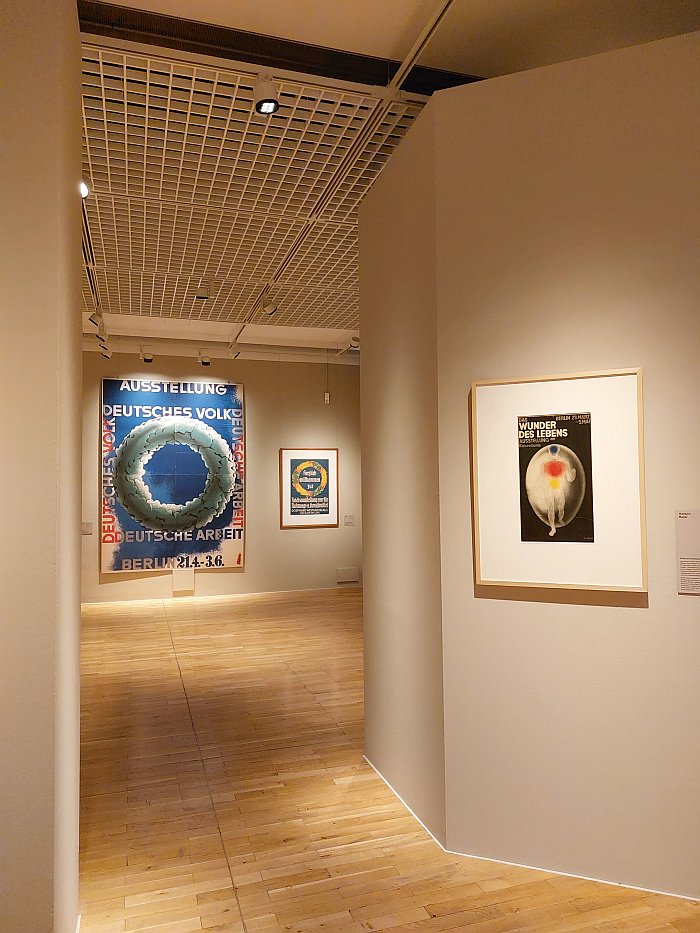
Similarly those who left didn't all leave for the same reasons, while some such as, for example, Johannes Itten, Herbert Bayer or Hin Bredendieck had a choice, or at least a relative choice, others such as Wassily Kandinsky, Paul Klee, Margarete Heymann-Loebenstein or Otti Berger had no real choice, an Otti Berger who, unless we missed others, apologies if we did, is the only Bauhäusler featured in Bauhaus and National Socialism whose murder at the hands of the NSDAP is mentioned in the course of the triumvirate: as noted from Otti Berger. Weaving for Modernist Architecture at the Temporary Bauhaus-Archiv, Berlin, having failed to establish herself in England Berger returned to her native, then, Yugoslavia, today Croatia, where in 1944 she was arrested and deported to Auschwitz. A fate in which the role of the NSDAP from the very beginning can be appreciated in Living in the Dictatorship via the the letter rejecting her 1934 attempt to join the Reichskammer der bildenden Künste, that NSDAP organisation of which membership was compulsory to work as a freelance creative.
Not that Berger was the only Bauhäusler murdered by the NSDAP, far from it, and the Bauhaus and National Socialism catalogue makes special note of the 25 whose murders are known, including Friedl Dicker whose invitation for the first Bauhaus Abend, those Bauhaus Salons that, as discussed in context of the Radio smow Bauhaus Playlist, provided for a informal extension of the formal teaching, were an expression of Gropius's understanding of Bauhaus as more than a school, and which were also, theoretically at least, a chance for exchange between the ragamuffins and the residents of Weimar, can be enjoyed in The Bauhaus as a Site of Political Contest; or a Willi Jungmittag whose photos in Living in the Dictatorship can, invariably are, read as typical Nazi propaganda shots, but who was a committed Socialist and antifascist, one of only very few Bauhäusler who actively resisted the NSDAP, and who was murdered in 1944 in Brandenburg an der Havel; or a Hedwig Arnheim whose work doesn't feature anywhere in Bauhaus and National Socialism, but whose biography is not only very much one of Bauhaus and National Socialism but also one of the social and cultural changes of the period, that wider context in which the (hi)story of the Bauhauses needs must always be considered, not just in terms of creative output.
Deaths at the hands of the NSDAP to which we'll add Hermann Gautel, a Bauhäusler not featured in Bauhaus and National Socialism, and only en passen in the catalogue, who, as discussed from Between Utopia and Adaptation shared a path from Oldenburg to Bauhaus with Karl Schwoon, specialised at, and after, Bauhaus in furniture, was called up for military service in 1940 and who was last seen in January 1945 near Kaliningrad. A Hermann Gautel who in all probability had absolutely no NSDAP sympathies, and whose death can be considered a result of the violence, inhumanity and warmongering of the NSDAP.
And a list of popularly known and relatively anonymous Bauhäusler and of varied and various biographies that not only helps elucidate just how much there is still to learn of, and learn from, Bauhaus, just how limited the contemporary popularly Bauhaus narrative is, but which also elegantly underscores how beyond the relevance of the creative biographies of the Bauhäusler in discussions and discourses on art, architecture, craft and design, the personal biographies of the Bauhäusler are equally as relevant in enabling better understandings of the human psyche, understandings that at this particular moment in the (hi)story of global society are essential, indispensable.
And that such is presented and discussed in Weimar in 2024 is not without its relevance and significance.
Where in 2024 if not Weimar?
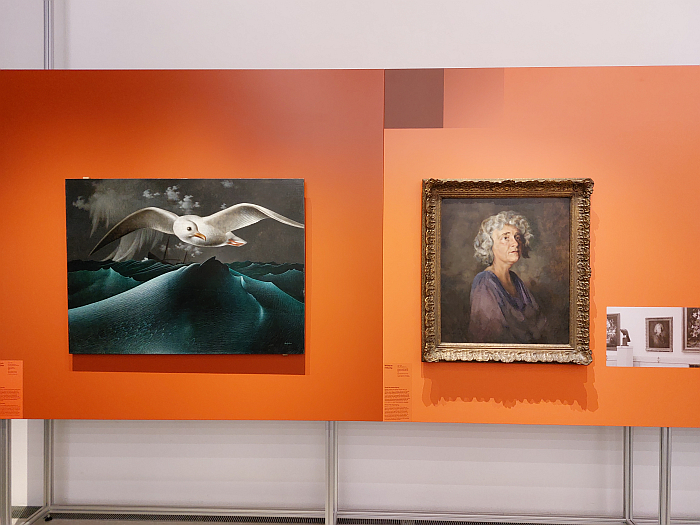
Whereby, why 2024?
Why not back in 2019 when Bauhaus Weimar celebrated it's centenary with a very high-profile German wide, arguably Europe wide, festival of exhibitions and events. A year long celebration of all things Bauhaus that, certainly in its popular medial reception, tended to reinforce the long recounted Bauhaus narrative. Why not in 2019?
???
Looking back it simply wasn't possible. In 2019 the established Bauhaus narrative was too strong, was definitive, was as invincible as the German Empire had once been.
But in many regards the exhibitions of 2019, and for all the research that was undertaken for those exhibitions, in many cases by a younger generation of curators than those who had worked on Bauhaus themes in the past, certainly on major Bauhaus anniversaries in times past, and the openness of the curators and the institutions in presenting the fruits of that research, were what began to chip a way at that narrative. Viewing the exhibitions of 2019 without the Bauhaus tourist gaze it became increasingly clear, increasingly obvious, stupidly so, that the accepted narrative simply wasn't sustainable.
Something that had been known in specialist and academic circles for a long time, but which couldn't find a public reception on account of the background noise of the established narrative.
2019 changed that.
2019 exposed the inconsistencies and contradictions in the Bauhaus narrative, forced one to question the probability of the established narrative and to dig deeper. With a bigger shovel. Whereby, inarguably, the first theme to actively popularly grasped was the rescuing of many of the female Bauhäusler from the anonymity into which they had slipped, according to the statistics in Living in the Dictatorship around a third of the identified Bauhäusler were females, a fact that, we'd argue, still isn't reflected in the contemporary popular Bauhaus image, the situation is without question better than it was before 2019, but still a long way from ideal. And while the myriad discussions on gender and the Bauhaus continue, other themes have increasingly come into focus since 2019 and in doing so have increasingly put pressure on the established narrative.
Or put another way: 2019 as a celebration of the established Bauhaus narrative marked the beginning of the end of the established Bauhaus narrative.
Which, to misappropriate Klaus Wowereit, ist auch gut so.
And while, yes, one can argue that through their centenary celebrations Bauhaus Weimar have kind of completely scuppered Bauhaus Dessau's coming centenary celebrations, means everyone will want to focus in Dessau on Nazis, and females and the DDR, we'd argue that the developments in the manner in which Bauhaus is discussed, the new openness in the public debate on and of Bauhaus since 2019, the acceptance of the incongruities in what we've all been told thus far, the fact that Stiftung Klassik Weimar can present a triumvirate such as Bauhaus and National Socialism with its very clear articulation of that which should have been discussed a long time ago, bodes very, very well for 2025.
Has opened a great many new perspectives which not only Dessau can work with and develop, but which allows the media and the public to approach Dessau 2025 without the baggage of (hi)story, without a reverence that denies a critical challenging, and thereby allow us all to approach that more probable Bauhaus narrative that it is without question important we develop.
Whereby, and as ever at this juncture, Bauhaus is, was and always will be but a component of not just creativity and creative eduction but the questioning of the future society of the 1920s and 30s, thus not only is Bauhaus and National Socialism an important subject but so is, for example, and staying in a Germanic context, Burg Giebichenstein and National Socialism or the Loheland-Schule and National Socialism. Bauhaus does however have a higher profile than most other institutions, often stands as a synonym for creativity in the 1920s and 30s, the lazy use of 'Bauhaus Furniture' to describe anything in steel tubing being an excellent example, and therefore the telling of a more probable Bauhaus (hi)story is of particular importance and relevance.
Bauhaus and National Socialism is an important step in that process not just because it is a project of Klassik Stiftung Weimar, those gatekeepers to so much of the pre and early Bauhaus (hi)story, but for all because it is the first large-scale public approaching of the subject; whereas, for example, Between Utopia and Adaptation, for all it regional focus, did allow for some important insights, confirmed how much was there to be discussed, and stimulated you to go there, and for all that Mathilde von Freytag-Loringhoven. Painter, Author, Animal Psychologist and Bauhaus Critic was an open invitation to explore the well-stocked archives in Thüringen, the subject was needing not only a wide-ranging discussion in order to inject impetus, but a wide-ranging discussion from a postion of authority to confirm that it is OK to add brown to the established Bauhaus palette of blue, red and yellow. And Bauhaus and National Socialism effortlessly fulfils that demand of it.
And that not least because while much of what it presents isn't new, although that said there is also a lot of new, more important is the presenting of, apparently, disparate material that normally isn't presented, discussed and explored together in a unifying concept, a presentation of that normally studied in isolation in new contexts and in new relationships that allows for differentiated perspectives. Yet despite its scope and range and variety, and satisfaction, Bauhaus and National Socialism isn't an end in itself, can't be, rather is but a start of a more honest exploration of Bauhaus, the Bauhauses, and National Socialism; as a triumvirate of independent yet inter-twinned and interdependent exhibitions Bauhaus and National Socialism is a framework, an accessible, universal and easy to use framework within which we can all start to re-explore, relearn and rewrite the narrative of not just Bauhaus, nor only the NSDAP, but of the relationships between creativity and politics, and also of the human in the totalitarian.
Something it will remain when, and if we've correctly understood, elements of the exhibitions are integrated into the permanent exhibition in the Bauhaus Museum Weimar, a space that needs the discussions on the NSDAP, on Bauhaus and the NSDAP, on Bauhäusler and the NSDAP, not only to set the discussions in the museum in the fuller context that is required, but also if the view across Weimar from the Bauhaus Museum to high up on the Effersberg and Buchenwald is to be truly meaningful. Truly informative and instructive. Because it's all one and the same (hi)story. And must be approached as such.
Bauhaus and National Socialism is part of the wider Klassik Stiftung Weimar 2024 theme year Auf / Bruch, a play on Aufbruch, awakening, starting, etc.
The Bauhaus as a Site of Political Contest, 1919-1933 is scheduled to run at the Museum Neues Weimar, Jorge-Semprún-Platz 5, 99423 Weimar until Sunday September 15th.
Removed – Confiscated – Assimilated, 1930/1937 at the Bauhaus Museum, Stéphane-Hessel-Platz 1, 99423 Weimar until Sunday September 15th.
Living in the Dictatorship, 1933-1945 at the Schiller-Museum, Schillerstraße 12, 99423 Weimar until Sunday September 15th.
Full details can be found at www.klassik-stiftung.de/bauhaus-and-national-socialism/
In addition a richly illustrated catalogue with numerous essays and Bauhäusler biographies, if sadly in German only, is available.
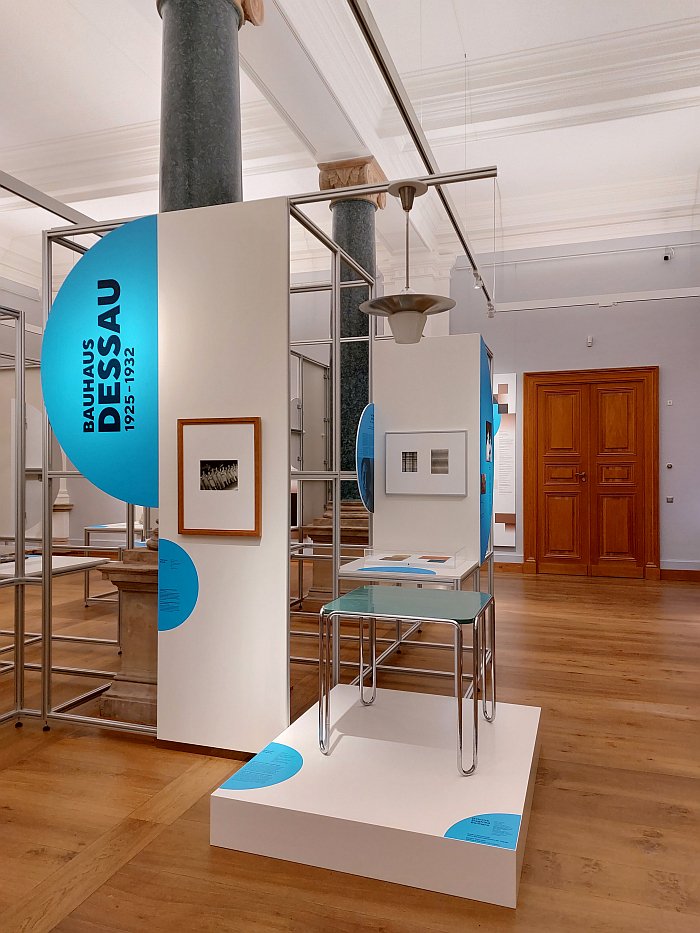
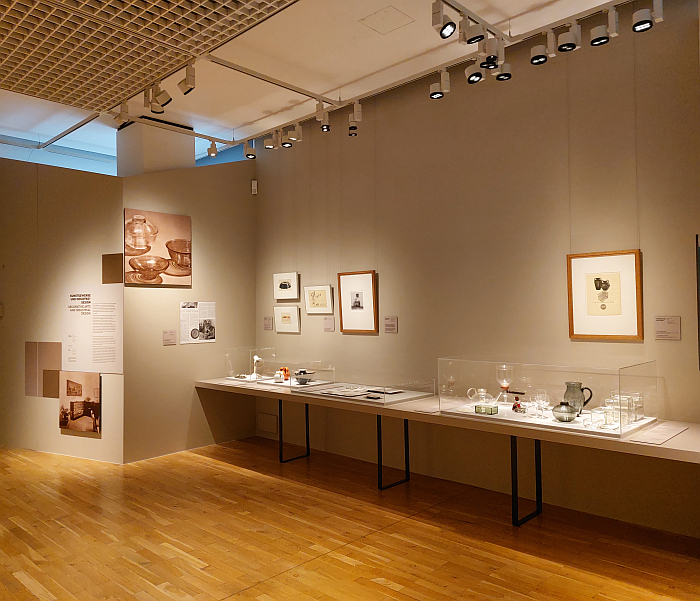
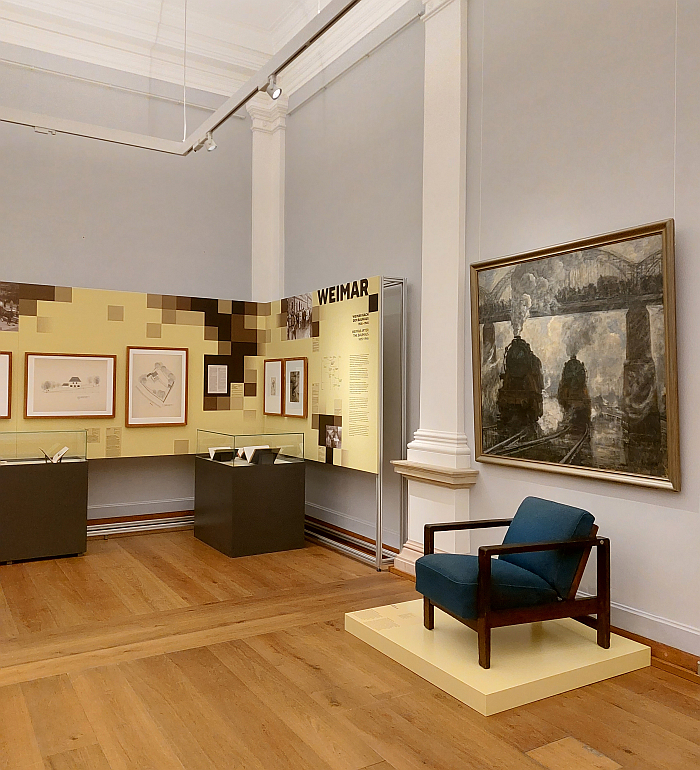
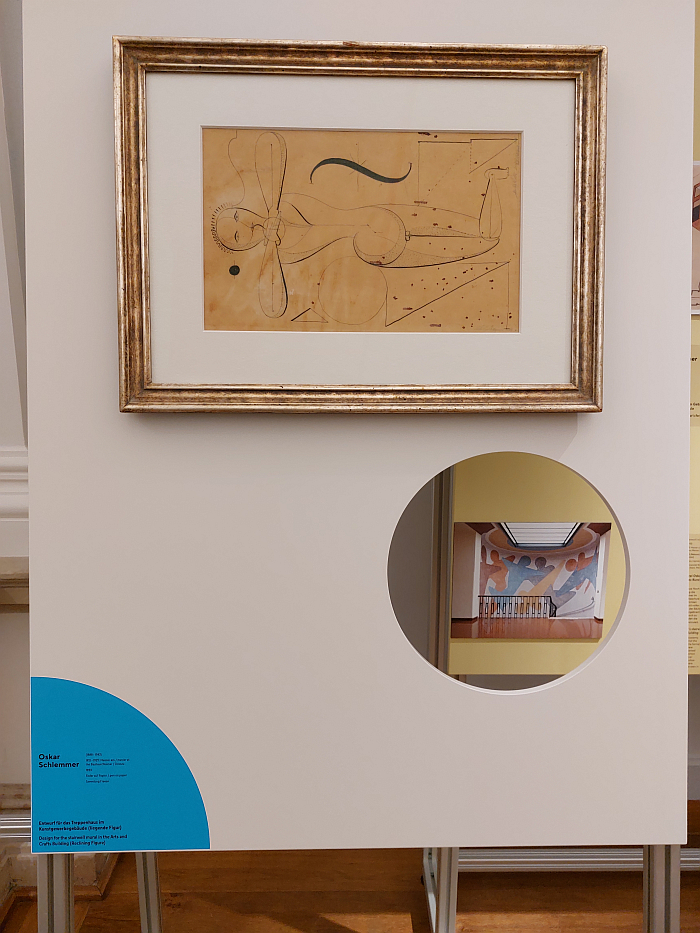
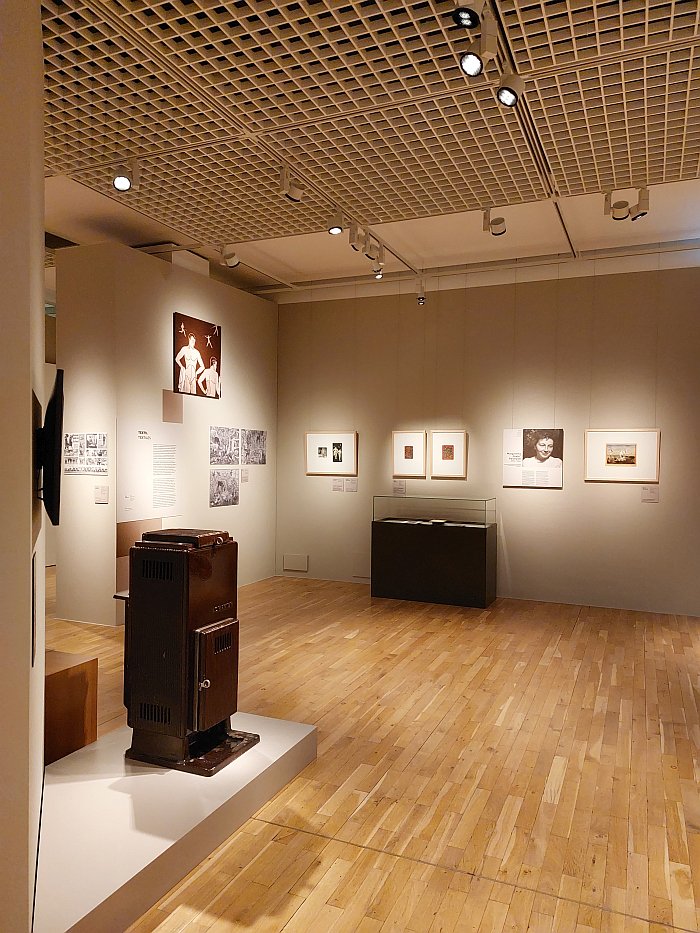
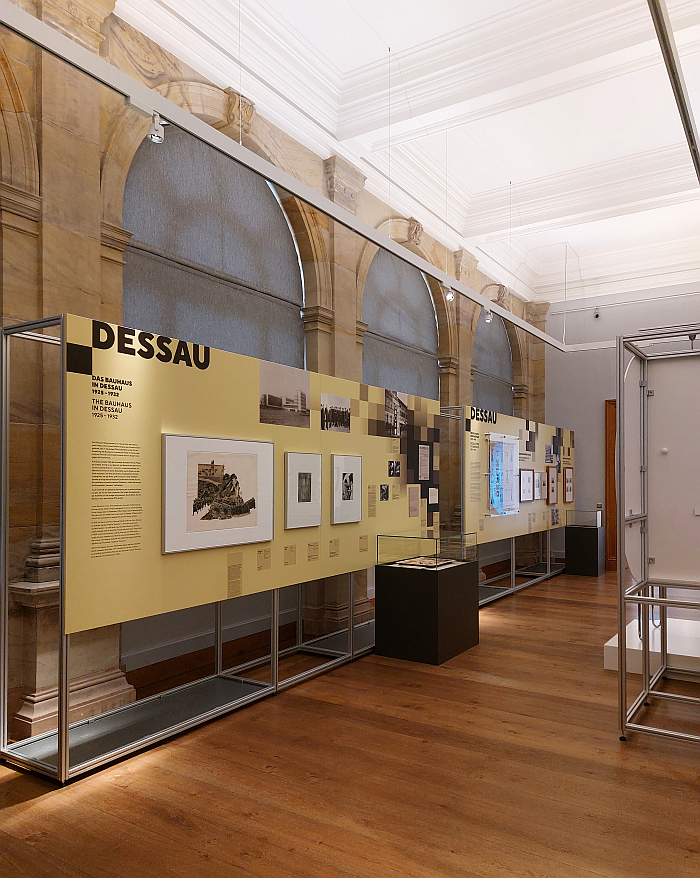
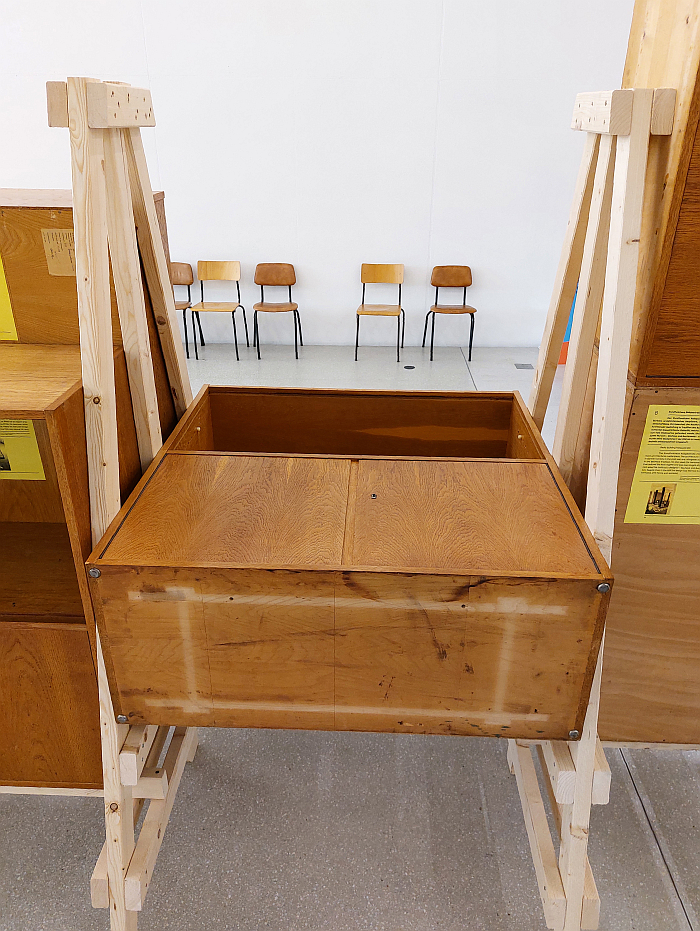
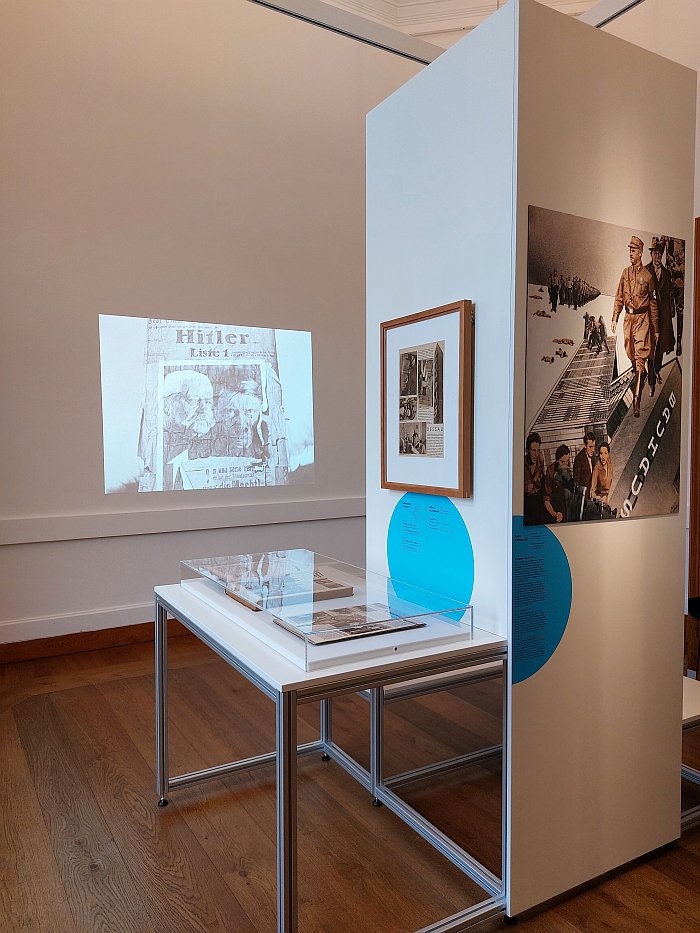
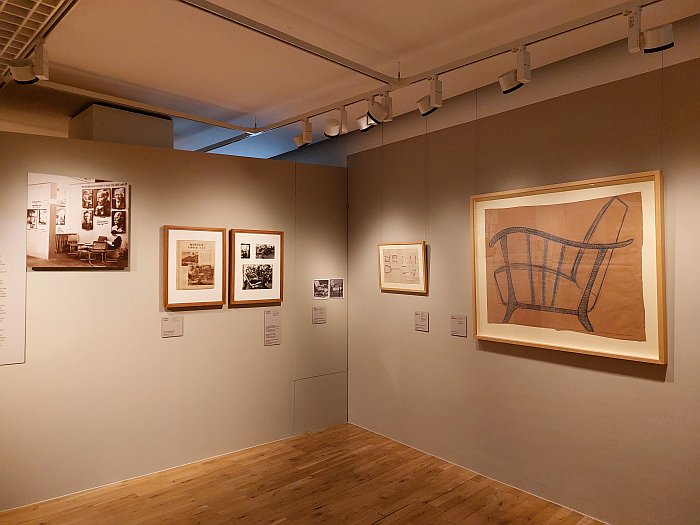
1Martha Ganter, Musikleben am Staatlichen Bauhaus in Weimar, Weimar–Jena:Die große Stadt, 5/3, 2012 182–190
2Elizabeth Otto, Marianne Brandt's Experimental Landscapes in Painting and Photography during the National Socialist Period, History of Photography, Volume 37, Number 2, May 2013
3Friedrich von Borries & Jens-Uwe Fischer, Gefangen in der Titolalitätsmaschine. Der Bauhäusler Franz Ehrlich, edition suhrkamp, Berlin, 2022